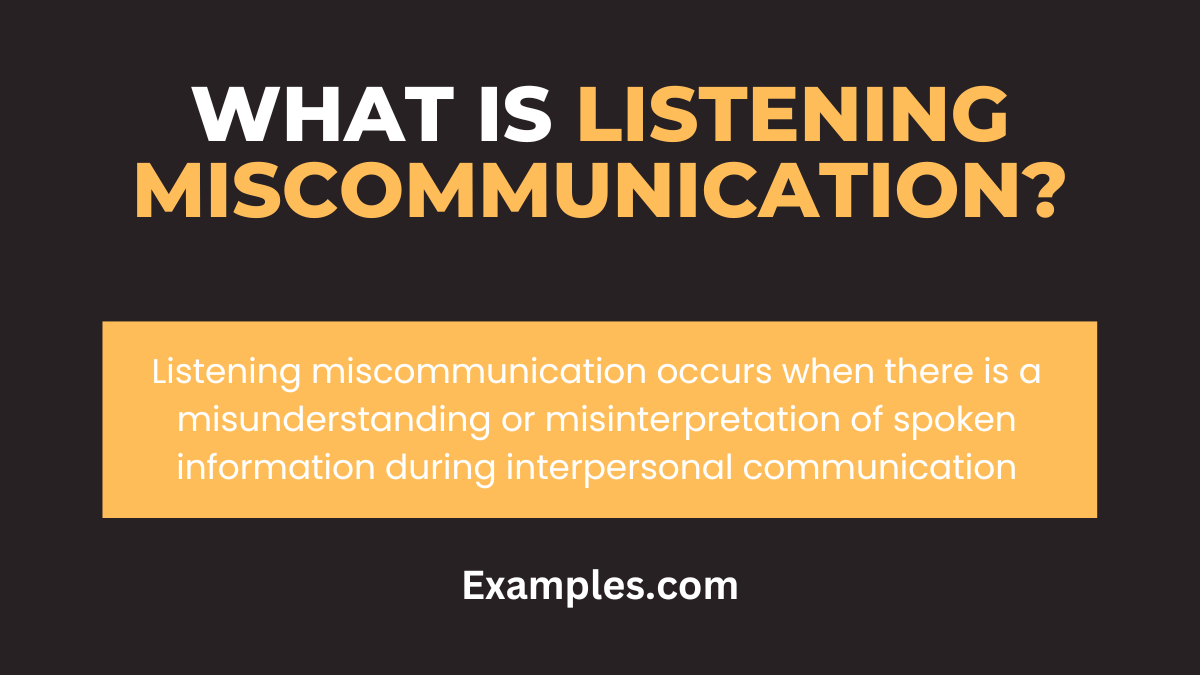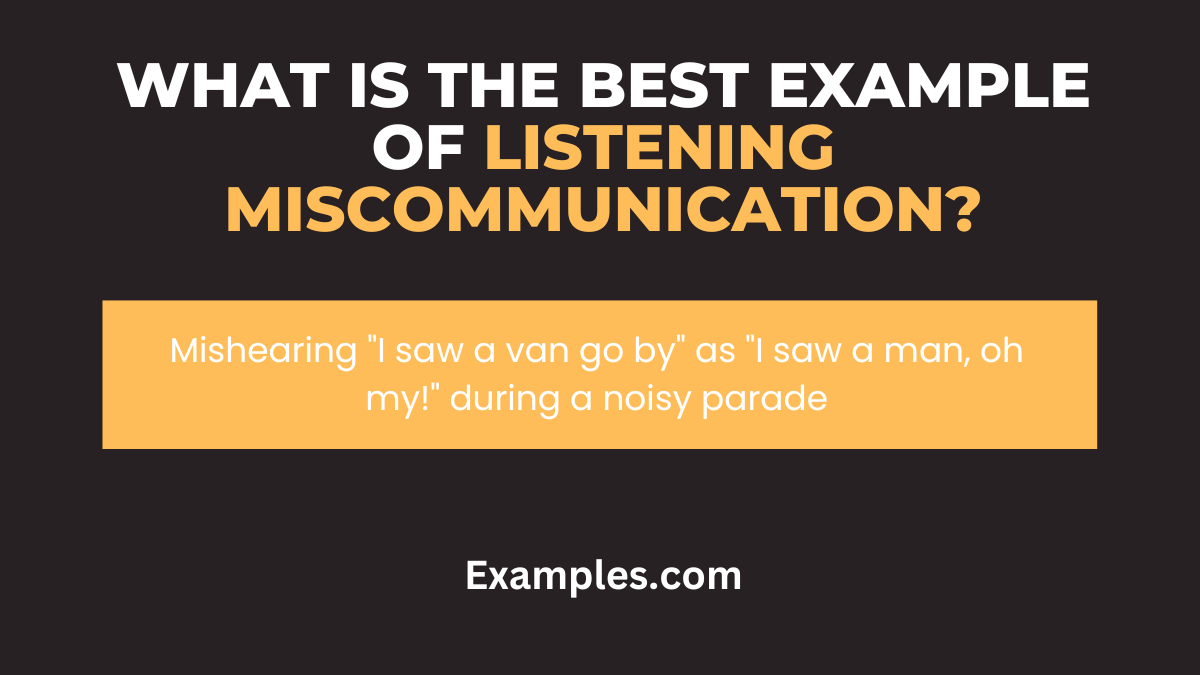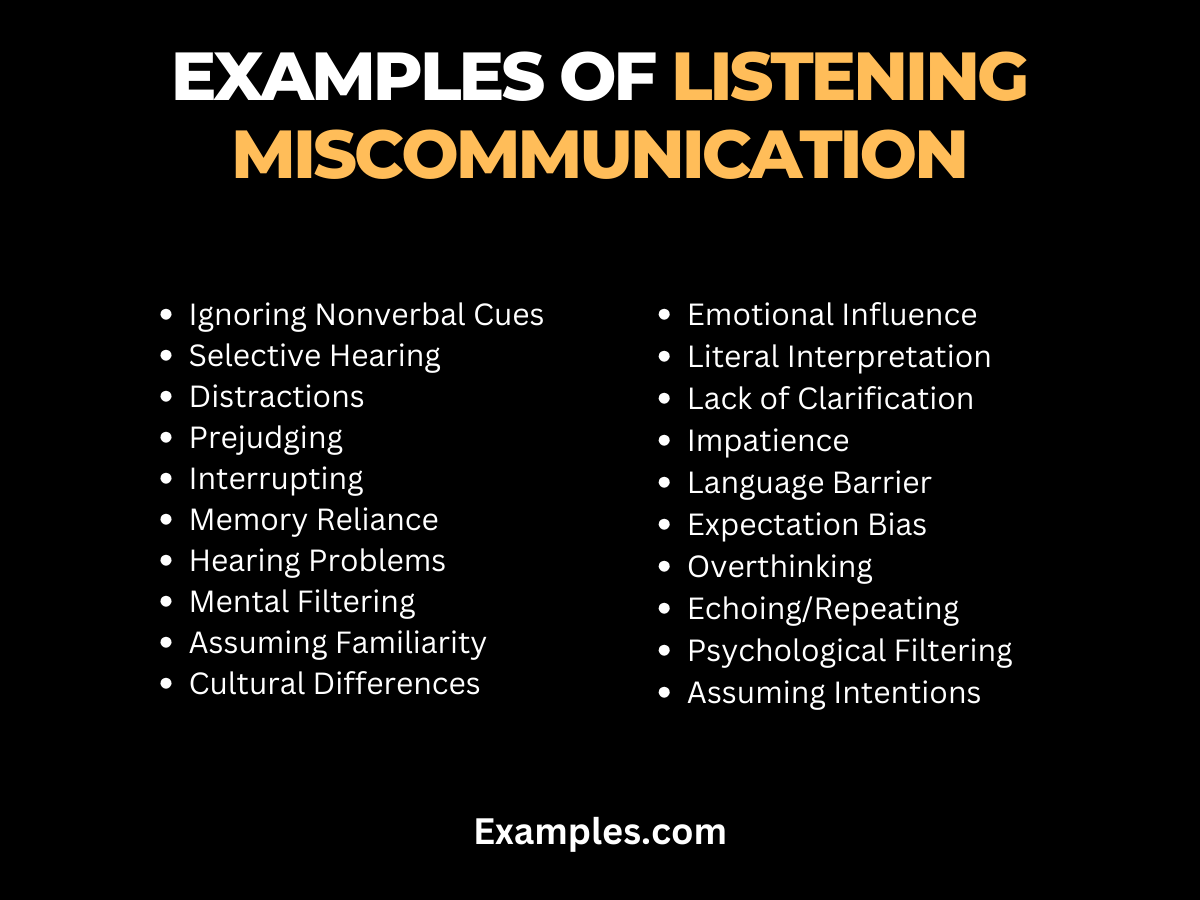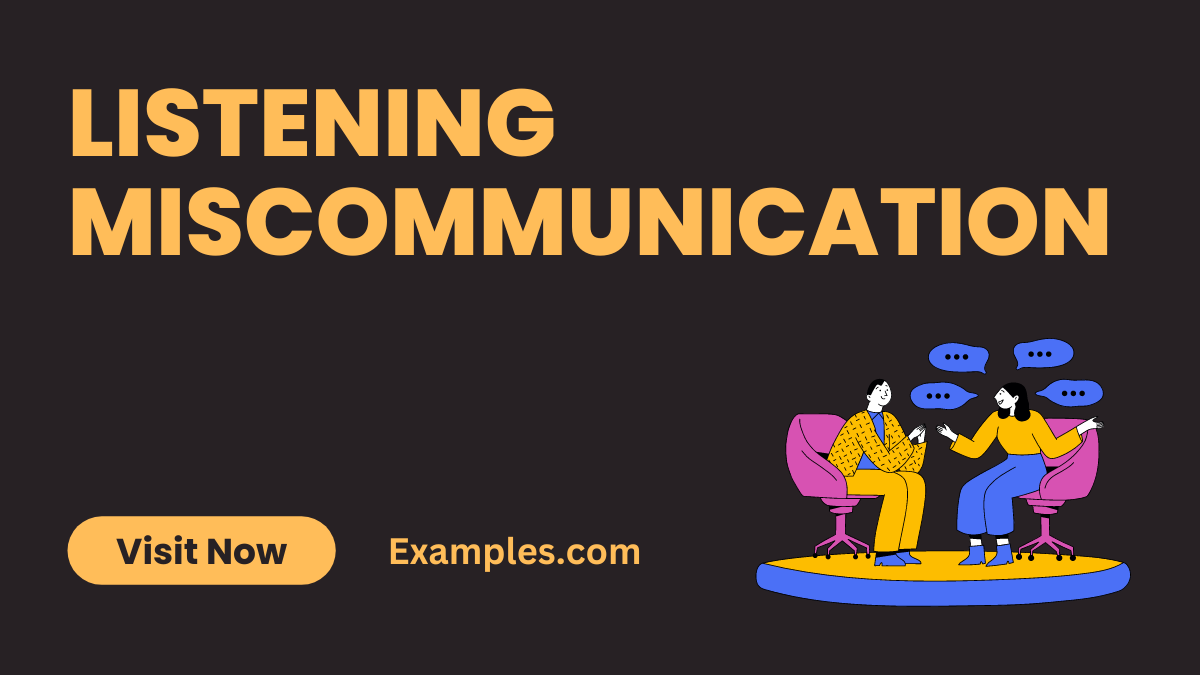19+ Listening Miscommunication Examples
Listening Miscommunication often leads to misunderstandings and conflicts, yet it’s a commonly overlooked aspect of communication. This guide delves into the nuances of listening miscommunication, highlighting its prevalence in various aspects of life, from personal relationships to professional environments. Understanding the intricacies of listening and miscommunication is crucial for building stronger, more effective communication skills. This comprehensive resource offers insights and practical tips to navigate and overcome the challenges posed by listening miscommunication, making it an invaluable tool for anyone looking to enhance their communicative abilities.”
What is Listening Miscommunication?

Listening miscommunication occurs when there is a disconnect between what is said and what is heard or understood. It’s a common issue in communication where the listener’s interpretation differs from the speaker’s intent, leading to confusion and misunderstandings.
What is the Best Example of Listening Miscommunication?

A classic example of listening miscommunication is in the workplace, where instructions or feedback are misunderstood, leading to errors in tasks or strained relationships. This highlights the importance of clear, effective listening and the potential consequences of miscommunication.
20 Examples of Listening Miscommunication

Listening miscommunication often leads to misunderstandings and conflicts in various aspects of life, from personal relationships to professional settings. It occurs when the listener misconstrues, overlooks, or forgets the speaker’s message. Recognizing and addressing these instances is vital for fostering clear and productive communication. This guide will explore 20 distinct examples of listening miscommunication, each accompanied by a brief explanation and example sentences to demonstrate effective communication strategies. These examples will illuminate common pitfalls and offer insights into how to navigate and rectify these misunderstandings.
- Ignoring Nonverbal Cues: Failing to notice the speaker’s body language can lead to misinterpretation.
Example: A nod is assumed as agreement, but it was just a polite acknowledgment. - Selective Hearing: Picking only parts of the conversation that interest you.
Example: Ignoring a friend’s worries while focusing only on their weekend plans. - Distractions During Conversation: External factors like noise or multitasking hindering effective listening.
Example: Misunderstanding a colleague’s request while checking emails. - Prejudging the Speaker: Forming opinions before fully hearing them out.
Example: Dismissing a new idea prematurely because of assumptions about the speaker. - Interrupting the Speaker: Cutting off the speaker leads to missing key information.
Example: Interrupting a client’s feedback, missing important details. - Over-reliance on Memory: Forgetting or misremembering parts of the conversation.
Example: Misquoting a supervisor’s instructions due to poor recall. - Physical Hearing Problems: Not acknowledging hearing difficulties can cause miscommunication.
Example: Misinterpreting a friend’s joke due to unaddressed hearing issues. - Mental Filtering: Focusing on a single aspect, ignoring the rest of the message.
Example: Concentrating solely on a negative comment and overlooking positive feedback. - Assuming Familiarity with the Topic: Overestimating understanding can lead to confusion.
Example: Misinterpreting medical advice by assuming familiarity with medical terms. - Cultural Differences in Communication: Cultural norms affecting interpretation.
Example: Misunderstanding a colleague’s indirect communication style due to cultural differences. - Emotional Influence: Personal feelings distorting the listener’s understanding.
Example: Taking constructive criticism personally and missing its value. - Literal Interpretation: Taking figurative language at face value.
Example: Confusion over idiomatic expressions leading to literal misinterpretation. - Lack of Clarification: Not asking questions when unsure about the message.
Example: Misunderstanding instructions and not seeking clarification. - Impatience in Listening: Rushing the speaker or not giving them enough time.
Example: Misinterpreting a slow speaker’s message due to impatience. - Language Barrier: Misunderstanding due to differences in language proficiency.
Example: Misconstruing words in a second language. - Expectation Bias: Hearing what you expect to hear, not what’s actually said.
Example: Assuming a friend’s agreement because you expect them to agree. - Overthinking the Message: Analyzing too deeply and missing the actual point.
Example: Misinterpreting a simple statement due to over-analysis. - Echoing or Repeating: Mimicking instead of actively listening and understanding.
Example: Repeating words without grasping their meaning. - Psychological Filtering: Personal biases and beliefs affecting interpretation.
Example: Misunderstanding a statement due to conflicting personal beliefs. - Assuming Intentions: Interpreting based on assumed intentions rather than actual words.
Example: Misconstruing a compliment as sarcasm due to mistrust.
Causes of Listening Miscommunication
- Preconceived Notions: Holding onto pre-existing biases can distort the listener’s understanding.
- Selective Hearing: Focusing only on parts of the conversation that interest the listener, ignoring other crucial information.
- External Distractions: Environmental factors like noise or visual distractions can impair listening.
- Emotional Responses: Strong emotions can hinder objective listening and lead to misunderstandings.
- Fatigue or Stress: Physical or mental exhaustion reduces the ability to listen attentively.
Listening Miscommunication in the Workplace
- Multitasking: Trying to do multiple tasks while listening can lead to miscommunication.
- Hierarchical Barriers: Power dynamics can intimidate employees, leading to incomplete communication.
- Jargon Overuse: Excessive use of technical language can create confusion.
- Assuming Understanding: Overestimating the clarity of a message can prevent further clarification questions.
- Lack of Feedback: Not providing feedback can lead to misunderstandings persisting.
Listening Miscommunication in Criminal Justice
- Cultural Differences: Diverse backgrounds can lead to different interpretations of the same information.
- Legal Terminology: Misunderstanding legal terms can lead to incorrect conclusions.
- Witness Stress: Stressful environments can affect a witness’s ability to communicate effectively.
- Interrogation Pressure: Pressure during interrogations can lead to miscommunication.
- Recording Limitations: Reliance on recorded statements can miss non-verbal cues crucial for understanding.
Preventing Miscommunication with Active Listening
- Full Attention: Give undivided attention to the speaker, minimizing distractions.
- Clarify and Summarize: Regularly summarize and clarify points to ensure understanding.
- Open Body Language: Use non-verbal cues to show engagement and understanding.
- Avoid Interrupting: Let the speaker finish their thoughts without interruption.
- Feedback Loop: Encourage feedback and questions to confirm understanding.
The art of effective listening is paramount to avoiding miscommunication. By following the provided guide and tips, you can navigate the complexities of interpersonal communication with greater precision. Remember that active listening fosters deeper understanding and connection, ultimately minimizing the potential for miscommunication in various interpersonal interactions.



